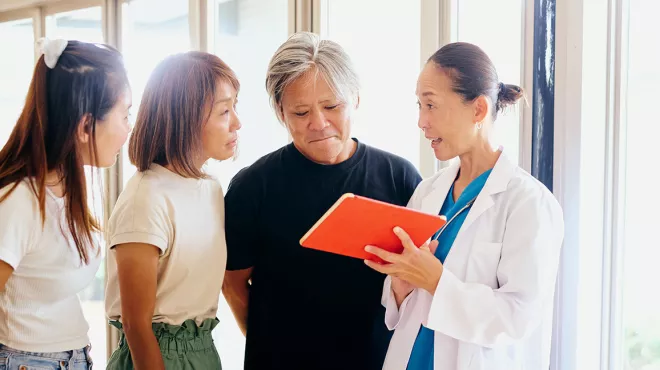Lisa, who lives with her family in Adelaide, Australia, began experiencing bouts of extreme fatigue about 18 years ago, and remembers being nearly asleep at odd hours of the day. Having two young children at the time, she shrugged it off as being a normal part of motherhood.
When Lisa’s fatigue worsened, she visited her doctor’s office. Her general practitioner diagnosed her with chronic fatigue syndrome, but Lisa still felt something was off and decided to get bloodwork done.
After Lisa’s blood tests revealed an abnormally high white blood cell count, she was referred to an oncologist, and within the first ten minutes of her consult, she was told she would be receiving a bone marrow biopsy. “I don’t believe the oncologist told me what he was testing was for,” Lisa said. Knowing nothing about leukemia at the time, Lisa recalled the experience as being shocking and confusing.
After a few weeks, Lisa received her unexpected diagnosis of chronic myeloid leukemia (CML), a cancer of the blood and bone marrow in which the body overproduces abnormal white blood cells1.
Lisa’s CML diagnosis came at a difficult time – her two young children were diagnosed with albinism, which severely impacted their vision, and she was grappling with the loss of her sister, who passed away from cystic fibrosis. Even with the family hardships, seeing her sister battle her illness gave Lisa the strength to face this new challenge head-on and take a leading role in her disease.
I'm not the type of person just to sit back. I challenged my doctor quite often, always asking questions, ‘What’s next? What can you do for me?
Confronting Challenges in CML
When Lisa was diagnosed, CML was still in its early days of research, and the treatments that are currently available today were not available outside of some clinical trials2. She was unaware of what the future would hold for her, “Back then, we didn’t have the Internet. I had to rely on the doctor for all my answers.”
Within a year of taking her first treatment, Lisa experienced significant side effects that made coping with her disease a challenge, and that resulted in Lisa’s doctor making the decision to switch her to a different therapy.
However, some patients still experience significant challenges, which may cause them to switch treatments multiple times either because their CML becomes resistant to treatment or because unmanageable side effects make it hard to adhere to treatment3. Over time, resistance or intolerance can emerge3.
In fact, over the course of her treatment journey, Lisa tried a few different treatments, with the primary reason behind switching being side effects like skin and bone pain, which was eventually diagnosed as neuropathic pain after multiple pain specialist visits.
With some of the switches in therapy, Lisa’s symptoms began to improve, as did her leukemic cell count or BCR-ABL levels. However, when Lisa’s CML numbers rose again, she switched to yet another treatment.
Unmet needs and challenges such as Lisa’s often result in the need to make difficult treatment decisions in partnership with one’s doctor.
Unfortunately, a year after her later switch into another treatment, Lisa and her doctor still weren’t seeing the expected results. It was then that she considered the option of going on a Phase I clinical trial for an investigative therapy. Lisa recalled being nervous and having many questions about trying an investigational treatment, but she made sure to have extensive conversations with her doctor in order to explore all available options and better understand the trial, which gave her the confidence to enroll.
Advocating for Yourself
Since her CML diagnosis, Lisa made sure to always speak up whenever she had a question or concern about her disease, “I'm not the type of person just to sit back,” Lisa said, “I challenged my doctor quite often, always asking, ‘What’s next? What can you do for me?’ – just to see what else is out there.”
Lisa emphasizes how crucial it is for new patients to conduct the proper research – whether it be into their diagnoses, available treatment options, or who their doctor is and how much experience they have treating CML. Additionally, there is a big support network for people who are newly diagnosed, says Lisa, “Patients shouldn’t think, ‘Oh, no. I’ve got this side effect, and it’s just me’ – you’re not alone.” Patients living with CML should not only consult with their doctor throughout their treatment journey, but also with other people living with the same disease in order to ask the correct questions and be their own best advocate.
Lisa says she is proud of herself for speaking up throughout her disease journey and advocating for herself as a patient. Although she experienced many challenges with side effects, keeping an open dialogue with her doctor allowed them to find the best path forward.
The Need for Additional Research
As a long-term patient with CML, Lisa feels that CML still needs to be researched. Despite the progress that has been achieved in recent decades, no cancer is a “good cancer” – patients and doctors still struggle to manage the disease, and there is much that can still be done to help the CML community. “My journey has been terribly, terribly hard,” said Lisa.
To anyone living with CML, Lisa’s words of wisdom are to keep fighting, even on the hard days, and to find your voice as a patient and advocate for your health. “Find a good doctor who’s experienced with CML, do the proper research, and ask the right questions,” says Lisa, “That can make a world of difference.”
CML patient Lisa shares her experience and discusses the importance of speaking up about unmet needs in your disease.



